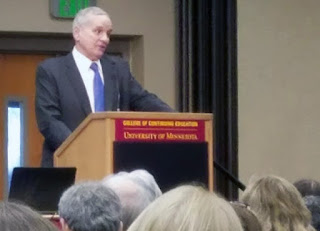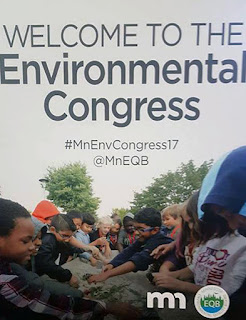
Stakeholder Engagement at the MN Environmental Congress
By Nicole Soderholm On February third the Minnesota Environmental Quality Board (EQB) arranged an event at the University of Minnesota’s St. Paul campus. The event was aimed at bringing together various stakeholders across different community sectors and industries to discuss ways in which our state could initiate meaningful action on environmental issues.
On February third the Minnesota Environmental Quality Board (EQB) arranged an event at the University of Minnesota’s St. Paul campus. The event was aimed at bringing together various stakeholders across different community sectors and industries to discuss ways in which our state could initiate meaningful action on environmental issues.
The EQB, which consists of ten state agency leaders and five citizens, dubbed this event the Minnesota Environmental Congress. While free to attend, participants were required to reserve tickets ahead of time due to limited space. It’s a good thing too, because the event filled up quickly!
The morning started out with a welcome speech from Governor Mark Dayton. Governor Dayton touched on a number of environmental issues, including the state’s buffer law that requires protective vegetation buffers on all public waters and ditches. Governor Dayton also praised the Obama administration’s decision to establish a twenty-year ban on copper-nickel mining near the Boundary Waters Canoe Area Wilderness.
The morning’s keynote speech was delivered by meteorologist Paul Douglas. Douglas highlighted the effects of climate change around the world and discussed innovations in clean energy. As Douglas noted, he remains “cautiously optimistic” about combatting climate change, citing a growing acknowledgement of the problem, new technologies, and the economic forces propelling clean energy markets and jobs. Douglas also discussed his new book “Caring for Creation,” which aims to present unique ways of framing climate change issues and solutions for a predominantly conservative, religious audience.
 |
| Photo credit: Environmental Quality Board |
The Congress offered both morning and afternoon break-out sessions where participants could choose topics that best fit their interests. Topics focused on Minnesota and included: climate change, energy, transportation, water ethics, pollinators, environmental regulation, community planning and civic engagement. Break-out sessions featured speakers or panelists, but each offered opportunities for audience participation. Some sessions featured long Q & A periods which helped to facilitate discussion, while others dedicated time for small group activities in an effort to enhance participation.
The Minnesota Environmental Congress was unique in that the attendees represented a wide variety of career sectors, interests and specialized knowledge from across the state. Farmer representatives, local planners, major developers, members of academia, regulatory agencies, the ethanol industry, environmental lawyers and community non-profits (to name a few) were all present at the Congress and spent the day interacting with each other. Visions and ideas for the future of Minnesota were shared and the forum allowed for better understanding between the different stakeholders present.
The EQB has been offering these events sporadically over the years. This year’s Environmental Congress was the first of its kind since 2013. Watershed District staff will keep an eye out for similar events to share with readers. The Congress proved to be a valuable opportunity for people with varying opinions and interests to come together and work towards a goal we all share: a better Minnesota for everyone.
“We ignore climate change at our peril. I ask people, ‘Do you love your kids?’ They say, ‘Of course I love my kids.’ I say ‘Well, do this for your kids, and their kids… They are going to wonder what you did’.” – Paul Douglas
For additional details, visit https://www.eqb.state.mn.us/environmentalcongress